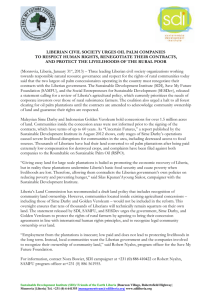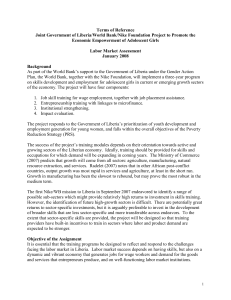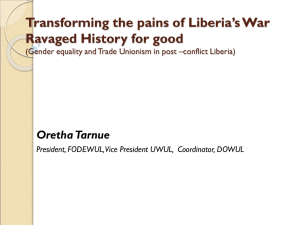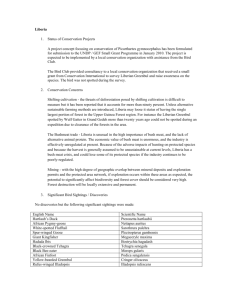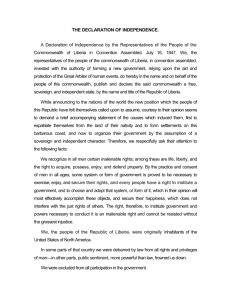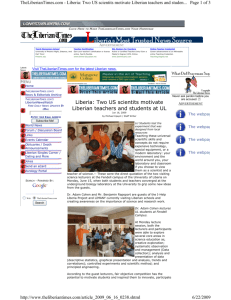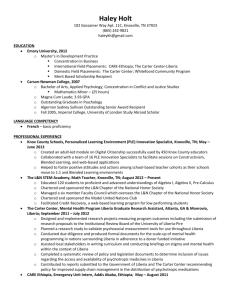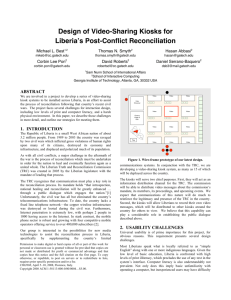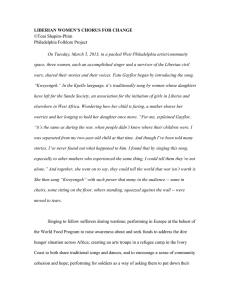Lessons from post-conflict AET capacity building efforts in
advertisement
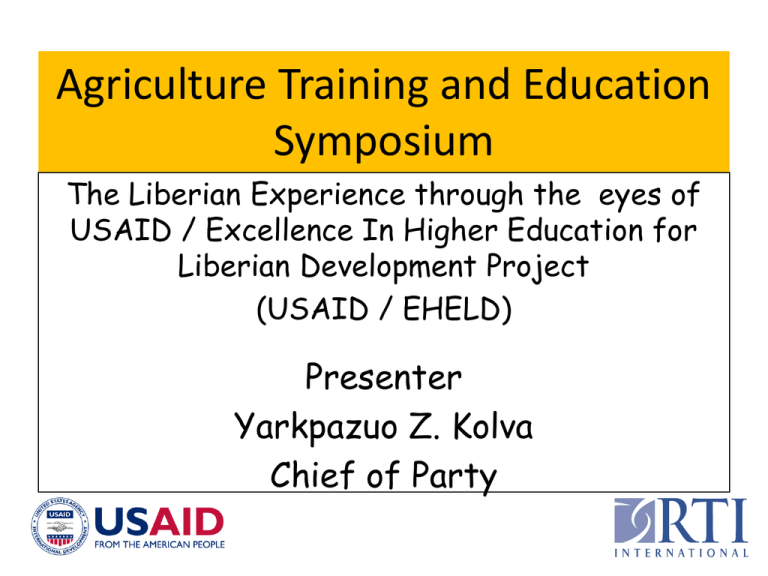
Agriculture Training and Education Symposium The Liberian Experience through the eyes of USAID / Excellence In Higher Education for Liberian Development Project (USAID / EHELD) Presenter Yarkpazuo Z. Kolva Chief of Party Republic of Liberia Socio-Demographic Indicators Population size (in millions) Population growth rate (%) Percentage of population under 15 yrs Life expectancy at birth Illiteracy rate (%) Percentage of population with access to education Population below poverty line (< US$1 per day) Total Geographic Area (km sq) Total Land area (km sq) Coastline (km) Year 2009 3.5 2.1 41.93 47 44 31.46 63.8 111,370 96,320 579 Liberia is endowed with a lot of Natural Resources • Fertile Soil & Plenty rain (6 months) • Abundant Rain Forest, est. b/w 900,000 hectares and 1.44 million hectares, • Plenty wide life, Natural plant products and wood, • On land – Iron ore, Diamond, Gold, several rivers and water falls for potential hydro power (St. John, St. Paul, Cavalla, Lofa , Kpatawee, St. John, LAC, etc, • Off land – Potential oil and natural gas, various fish species, good coastal land for tourism, Eco-tourism Liberian Agriculture Decline • For many decades, Liberia experienced relative stability (1847 – 1979) – Subsistence Farming (slash & burn farming system based on cutlass & hoe technology, i.e. no mechanization) – Agriculture sector gradually grew and boom (cash crops – rubber, oil palm, coffee, cacao, etc. • Liberia has seen tremendous problems and obstacles in its path since 1979. – Coup d'état of 1979. – Civil Conflict / War 1980’s- 2003 Background Civil war destroyed much of Liberia's economy, especially the infrastructures. – Most businesses to include farming businesses were disrupted, close down, etc. – formal economic activities collapsed. – Many businessmen fled the country, taking capital and expertise with them. – Farmers fled their farms, farms assets were looted and destroyed Stability returned to the country in 2003 and we have just celebrated 10 years of Peace & Steady Growth. Liberian Higher Education Background • Liberia’s universities pre-conflict – – – – Strong curriculum Well qualified faculty Well equipped facilities Strong relationships: public and private sector; peer universities • Liberia’s universities post-conflict – Outdated curricula – Aging faculty, lacking history of professional development and higher degrees – Poor buildings – Few functioning laboratories – Lack of textbooks and other resources FEEDBACKS / OUTCOMES UNIVERSITIES • General decline in standards • Increasing irrelevance in curriculum • Graduates ill-prepared for work • Poor contribution from higher education to Liberian economic growth • High non-completion rate (3000 enrolled in engineering @ UL, 30 graduates • High failure rates • 50% studying business and management • 23,000 take entrance exam, 9,000 enrolled (2012) • 25,000 take entrance exam, 1,800 enrolled (2013) HIGH SCHOOLS • High school graduates are ill prepare and perform poorly on WAEC Exams • High school teachers have low capacities (low salary, low literacy & numeracy level) • Inadequate learning environment (no texts books, no electricity, no computers • Most high schools graduates are ill prepare & don’t want to consider professional career in national building & wealth generating areas, agriculture, engineering , etc “It is not Condition, but Decision and Action that Determine one’s Destiny” -Anonymous- Contribution Toward A Solution USAID-funded Project • Excellence in Higher Education for Liberian Development (EHELD) • 5-year project awarded to RTI International (2011-2016) • Subcontract partnership (Rutgers University, University of Michigan, North Carolina State University and ARD Tetra Tech, • Programming Areas – Pipeline Development – Create Centers of Excellence in Agriculture at Cuttington Univ. & Engineering at Univ. of Liberia – Employer Engagement Overall objective To increase the wealthgenerating capacity and capability of Liberia’s graduates EHELD Objectives • Increase number of students who select and succeed in agriculture and engineering majors at Cuttington University and University of Liberia respectively • Development of Agriculture and Engineering programs that provide highest quality education in line with international best-practice • Increased employment opportunities for the graduates of Agriculture and Engineering programs WORK READINES S BUSINESS SKILLS VALUE ADDING ACCELERATED LEARNING PROGRAMS (SMART, FAST & SUMMER) INT’L EXPERTISE, CURRICULUM DEVELOPMENT, LABS & SChOLARSHIPS FACULTY and FACILITY DEVELOPMENT STUDENT PIPELINE BUSINESS PARTNERSHIPS & INTERNSHIPS OUTREACH Successes & Challenges Implementing a Higher Education Program in PostConflict Liberia EARLY HARVEST / ACHIEVEMENTS Successful operated 3 years Pipeline programs • Reached over 10,000 high school students (Pipeline programs) who have expressed interest in pursuing careers in Agr. & Eng. Center of Excellence in Agriculture • Improved the learning environment (good classroom facilities, resource center (e-learning), outdoor and indoor laboratories facilities to reinforce learning, • Recruited visiting and contract faculties (expertise knowledge) • Developed new agriculture curriculum (2011) and rolled it out 2012/2013 academic year • Awarded 96 scholarships (53% Male & 47% female) • Developing the future faculties (awarded 8 scholarship for post-graduate training (USA – 2, Ghana -6) EARLY HARVEST / Achievements Cont. Center of Excellence in Agriculture • Successfully operated 15 short term training courses (reaching out to NGOs, Communities, farmers, etc.). Employers engagement • Developed good working relationship with public and private sectors. – – – – Provided inputs and feedbacks to new agriculture curriculum development process (2011) Awarded scholarship through the project to students enrolled in the programs Sponsored summer start program (Fast start and summer) Provided paid internship opportunities to students Strong Partnership • • Amongst key stakeholders (RU, NCSU, UoM, CU & UL) Peace Corps Liberia, Vet. Without Border USA, First Avenue Int’l., Public and Private sector CHALLENGES Nationally • Ill prepared High School graduates • The field of agriculture is not nationally prioritize as reflected in national budget (< 7 percent & mainly for salaries and operations) • Lack of Government specialized programs and Funding toward agricultural development in terms of grants, scholarships, research awards, fellowships, etc. • Slowly growing agricultural industry that relies heavy on exported products install of home grown food. • Main agriculture development activities are focused on cash / tree crops (rubber, oil palm, cocoa, and coffee) CHALLENGES Cont. • Level of University engagement & time constrains it takes to work with locals • Compensation for local staff (Budgetary constraints) • Limited University Staff members available for trainings • Too much compelling needs • Inadequate funding (genuine needs) • Affirmative actions (focused to acquiring gender equity, also called gender equality for awarding scholarship) • Lack of an entrepreneurship zeal amongst students (Employees as opposed to employers) • Lack of role models (youth are uneducated & unskilled) They are not interested in agriculture production activities. Thank you!
